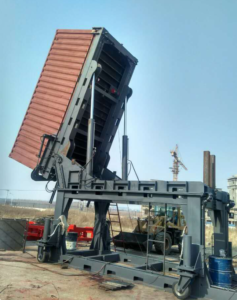Container Tilters and Upenders: Optimizing Material Handling
Container tilters and upenders are essential tools for efficiently loading and unloading goods, especially when dealing with bulk materials or items that require specific orientations. This guide explores the functionality, components, and applications of container tilters and upenders, providing a comprehensive overview for fabrication professionals.
Understanding Container Tilters and Upenders
These machines reorient ISO containers, transitioning them from a horizontal to a vertical position (or vice versa). This reorientation facilitates easier and safer material handling. The process greatly reduces unloading times and ensures consistent material flow where applicable.
Key Components and Their Functions
Container tilters and upenders consist of several integral components working in unison:
Reinforced Frame: The backbone of the system, constructed from reinforced I-beams and robust metal plates. This frame is engineered to withstand the immense weight of loaded containers, typically up to 30-40 tons for a standard ISO container.
Hydraulic Lifting Cylinders: These cylinders provide the lifting force required to elevate one end of the container, creating a pivot point for tilting or upending.
Pivoting Mechanism: A sophisticated mechanism that uses hinges, bearings, and gears to smoothly rotate the container through 90 degrees or more. This mechanism ensures controlled and precise movement during the reorientation process.
Control System: Programmable hydraulic valves and sensors precisely manage positioning and height, offering accurate control during the tilting or upending procedure.

bi directional container upender4 Design and Structural Considerations
Frame Reinforcement:
The frame must be exceptionally strong, designed with reinforced I-beams, trusses, and thick metal plating to handle the considerable load of a fully loaded container.
Hydraulic System Reliability:
A reliable hydraulic system is essential for smooth and controlled lifting and tilting. Proper maintenance and high-quality components ensure long-term reliability.
Applications Across Industries
Container tilters and upenders find applications in various industries including:
- Warehousing and Logistics: Streamlining the loading and unloading processes.
- Agriculture: Handling bulk grains and other agricultural products.
- Recycling: Facilitating the efficient processing of recyclable materials.
- Manufacturing: Optimizing the handling of raw materials and finished goods.
Customization for Specific Needs
Container tilters and upenders can be customized to accommodate various container sizes, including 20-foot, 40-foot, and high-cube containers.
Outdoor Installation:
Outdoor installations often require protection against weather elements to ensure smooth operation year-round. High isolation levels of electrical components are crucial for safety.
Safety Features
Several safety features are critical:
- Guards: Physical barriers to prevent accidental contact with moving parts.
- Two-Hand Controls: Requiring the operator to use both hands to activate the machine, preventing accidental operation.
- Non-Slip Surfaces: Providing secure footing for operators.
Maintenance and Reliability

Regular maintenance is essential for ensuring the reliable performance of container tilters and upenders. Key maintenance points include:
- Hydraulic Fluids: Regular checks and changes to maintain optimal performance.
- Seals: Inspection and replacement of worn seals to prevent leaks.
- Bearings: Lubrication and inspection of bearings to ensure smooth operation.
- Pivoting Mechanisms: Regular checks and adjustments to maintain smooth rotation.
By following these guidelines, fabrication professionals can maximize the efficiency and safety of their material-handling operations. For further information, contact info@fhopepack.com or visit www.fhopepack.com.